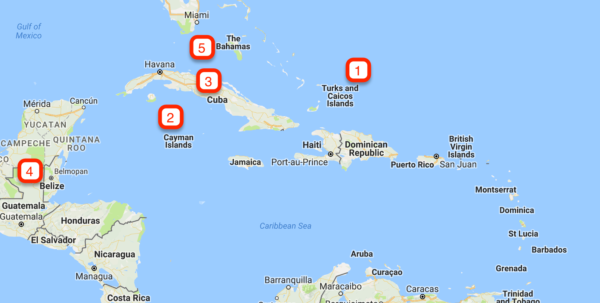
Are you feeling intimidated diving from liveaboards? Fear not! I have great news for you. I have 5 of the best liveaboard scuba dive trips in the Caribbean.
There are liveaboards who actually cater to you because you need to start somewhere if this is what you’re yearning to experience. Location, the boat, the type of diving in addition to the type of service you get will be important factors for you.
You might be interested in reading my article of why divers and non-divers love to live and dive from liveaboards.
By the time you finish your liveaboard vacation, you could have an additional 22 to 32 dives logged on this trip. Many liveaboards also offer PADI’s Advanced Open Water Diver Certification and Nitrox course to give you an even better dive experience. You will no longer be a beginner diver.
In this article, I’ll give you recommendations of 5 great dive destinations in the Caribbean which you can do from liveaboards. I’ll describe the type of diving, the best times to go and the best liveaboards for new divers. There are also some exciting videos to watch.
Remember to bring your dive log book because some liveaboards want to know if you did a dive within the year before diving.
1) Turks & Caicos Islands
The Turks & Caicos Islands are located in the tropical Atlantic Ocean, just south of the Bahamas, 550 miles southeast of Miami, Florida, and east of Cuba and the Dominican Republic.
As part of the British Overseas territory, it consists of 40 islands and cays, with only 8 inhabited. English is the main language with US currency.
The islands, as the belongers say is ‘Beautiful by nature!’ because of its captivating turquoise waters and one of the finest sandy white beaches.
Recently awarded the 2017 Travellers Choice (Trip Advisor), it’s known to divers who come from all parts of the world, as their ‘divers paradise’.
I lived in Grand Turk, the capital of Turks & Caicos Islands for 4 ½ years and the islands truly have one of the most pristine abundances of the coral reef ecosystem. This is because most of the coastline is protected by the government’s National Parks Ordinance.
If you have never heard of the famous Columbus Passage, it’s a 22-mile wide channel that separates the Turks from the Caicos. It’s the salt water’s highway for the passing migration of thousands of humpback whales, turtles and rays from January thru March.
Quite often when diving and snorkeling, you can hear the humpback whales sing their love songs to entice female whales.
The islands are known for it spectacular and breathtaking vertical wall dives (6,000 – 7,000 ft deep), that are easy for divers of all experiences. It’s actually one of the best places to learn how to scuba dive in my opinion because of its clear visibility, warm water temperature and 95% of the time, no current.
Best Suited For: Divers of all levels and snorkelers.
Type of Diving: Shallow diving, vertical wall diving, reef diving, wreck diving, tunnel diving, night diving.
Water Temperature: Usually average is 72 to 78 degrees F/23-26 degrees C winter months and 82-84 degrees F/23-26 degrees C in the summer.
Currents: Very little to none.
Visibility: Water is clean and usually very clear. Visibility can be from 25 to 40 metres/80 to 130 feet.
Best Diving Depths: 30 – 60 ft.
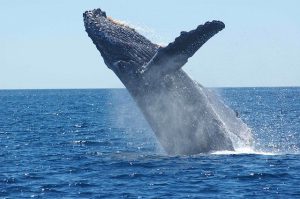 Humpback whales: (January – March). Bring your family to see an exhibition of these humpback whales migrating.
Humpback whales: (January – March). Bring your family to see an exhibition of these humpback whales migrating.
Other Sea Creatures Highlights:
Hammerhead sharks, Nassau groupers, eagle and giant manta rays, sea turtles, reef sharks and nurse sharks, plentiful of colourful coral, sponges, tiger sharks, huge gorgonian fans, fat lobsters and crabs, sea horses, dolphins, spotted and moray eels, juvenile drum fish, bonefish, great variety of tropical fish etc.
Other Features: Caverns and tunnels, coral-covered reefs.
Glorious sunsets and on a clear evening and looking straight out into the ocean’s faraway horizon just before the sun disappears, without blinking an eye you should see the ‘green flash’.
Best time to go: While diving and snorkeling are year-round, you must consider the hurricane season (June to November). The best time to go is mid-November to May
Recommended Stay: 7 nights
Departure Port: Providenciales (Turks & Caicos Islands)
BEST RECOMMENDED LIVEABOARD BOAT: Turks & Caicos Explorer II (27 dives)
2) Cayman Islands
Cayman Islands surrounded by the Caribbean Sea and located north of Panama, east of Mexico and south of Cuba, is made up of 3 small islands:
- Grand Cayman
- Cayman Brac
- Little Cayman
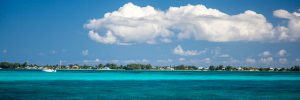 The diving is similar to Turks & Caicos Islands.
The diving is similar to Turks & Caicos Islands.
The Cayman islands, ringed by its great coral reefs are known for its spectacular wall diving, white sandy beaches, stunning swim throughs, outstanding coral and wreck dives.
With visibility that seems to go forever and their alluring 365 dive sites, you can’t go wrong when they say they offer the best Caribbean diving.
The most popular place for divers is Grand Cayman with its breath-taking wall diving called the North Wall. It has a quick vertical drop deeper than 6000 ft/1800 meters so be sure to look down or you’ll miss the sharks and spotted eagle rays swimming below you.
Bloody Bay Wall Marine Park at Little Cayman is acknowledged for its enticing swim throughs, wicked drop-offs, exotic and vibrant coral colors – this is where I do most of my dives. Start your dive at around 30 ft and before you know it, you’re in the blue abyss of the deep.
Cayman Brac offers many types of diving for the newly certified to the experienced divers. For instance, their wreck diving, wall diving, and reef diving are all very appealing and easily accessible.
For all you newbies and novice divers, there’s this ship called Captain Keith Tibbets, a Russian ship, it’s intentionally sunk and is a world on it own full of different marine life.
Best Suited For: Recommend you have at least 20 logged dives. New and experienced divers, snorkelers.
Type of Diving: Shallow diving, vertical wall diving, reef diving, wreck diving, night diving.
Water Temperature: Year-round average is 78-82 degrees F/26-28 degrees C.
Currents: Very little to none.
Visibility: Depending on the weather, most often excellent, water is usually very clear, clean, and visibility can be to 60-100 ft./18-30m or greater.
Best Diving Depths: Shallow – 60 ft. plus!
Sea Creature Highlights: Spotted eagle rays, sea turtles, sharks, stingrays, juvenile drum fish, groupers, moray and spotted eels, crabs, lobsters, gigantic orange elephant ear sponges, wire coral, gorgonian fans, black coral, flounders, octopus, squids, a massive variety of tropical fish, etc.
Other Features: Excellent snorkeling. Feed stingrays. Onshore excursions, you can snorkel and go for long walks along the beaches.
Best time to go: While diving and snorkeling are year-round, you must consider the hurricane season (June to November). The best time to go is mid-November to May
Recommended Stay: 7 nights
Departure Port: George Town
BEST RECOMMENDED LIVEABOARD BOAT: Cayman Aggressor V (32 dives)

3) Cuba
Ahhh yes, you gotta check out earth’s hidden paradise, the wonders of the Jardines de la Reina is also known as the Gardens of the Queen.
Looking for adventure?? The regular divers who keep coming back call this place as the Galapagos of the Caribbean!
Cuba is located west of Haiti, north of Jamaica, east of Cayman Islands, south of Florida Keys and the Bahamas. When you look on the map, you’ll see it’s right in the northern part of the Caribbean where all three waterways meet, the Caribbean Sea, the Gulf of Mexico and the Atlantic Ocean.
The Jardines de la Reina (even the name sounds romantic) is an archipelago (groups of islands) 50 miles south of Cuba’s mainland and features the magnificent landscape of massive canyons and caves.
The area is protected with no commercial fishing allowed and no human habitats. It’s Cuba’s natural marine park and is 90 miles long and around 20 miles wide.
Can you imagine being in the middle of this wilderness of huge marine life – reefs covered by healthy sponges, black coral, schools of diverse types of fish and 150 miles of mangroves?
Shortly after I left Turks & Caicos, I just had to make a pitstop and dive in the Jardines de la Reina. I did this because of its name and from the urging of my fellow divers and my dream to see whale sharks here.
I did not get to see one whale shark but I hope you’ll get the experience!
Divers tell me it’s like an orgy when the hungry whale sharks, the young tuna and the humongous supply of herring all feed on this massive swarm of zooplankton. What’s happens next is the sharks zoom in on the tuna and the seabirds participate by swooping in the water to scoop the leftovers.
Snorkelers and divers love to explore the different types of reef formations, walls, mangroves, and seagrass beds. Occasionally, you may see swimming by you, the Goliath grouper, the loner, also known as jewfish because they’re huge.
Best Suited For: New to advanced divers and snorkelers. No minimum logged dives required.
Type of Diving: Shallow diving, wall diving, reef diving, wreck diving, night diving.
Water Temperature: Year-round average is 77-81 degrees F/25-27 degrees C.
Currents: Very little to none. Protected from winds and currents.
Visibility: Depending on weather, excellent, water is usually very clear and clean.
Best Diving Depths: Shallow – 60 ft. plus!
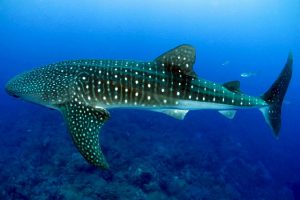 Sea Creature Highlights: LARGE FISH!!
Sea Creature Highlights: LARGE FISH!!
Atlantic Goliath grouper, Cubera snapper, bonefish, very large conchs, whale sharks, hammerhead sharks, reef sharks, yellowfin grouper, black coral, hawksbill turtles, large sponges, tuna, huge gorgonian fans, eels, king mackerel, etc.
Other Features: Crocodiles, and you meet with Cuban biologists.
Best time to go: November – May. Whale sharks July – November which is also in the hurricane season.
Recommended Stay: 7 nights
Best diving depths: 30 – 60 ft. plus
Departure Port: Jucaro
BEST RECOMMENDED LIVEABOARD BOAT: Jardines Aggressor I (22 dives)

4) Belize
Video of divers diving from the Belize Aggressor III…
Popular for its long white and sandy beaches, it has over 400 islands with a lot of history.
Home to the famous Mayan ruins and one of the smallest nations of Central America, Belize can also boast of having the second longest continuous barrier reef (190 miles/300 kilometers) in the world. It produces one of the richest marine life in the Caribbean.
Belize also has this gift of beauty and mystery when it comes to the Great Blue Hole which extends over 984 ft/300m across and 354 ft deep/108m in a circular pattern.
Divers from all over the world come to dive in the Great Blue Hole, a gigantic sinkhole located about 43 miles from Belize City. It’s no wonder, Belize offers one of best classiest scuba diving in the world.
Best Suited For: New and advanced divers, snorkelers. Prerequisite recommendation – minimum of logged 20 dives completed.
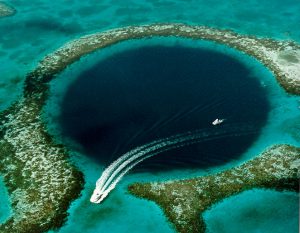 Type of Diving: Shallow diving, wall diving, tunnel diving, reef diving, wreck diving, blue hole diving weather permitting, night diving.
Type of Diving: Shallow diving, wall diving, tunnel diving, reef diving, wreck diving, blue hole diving weather permitting, night diving.
Water Temperature: Between 75 – low 80 degrees F/24-27 degrees C. December – April. May – November 85 degrees F/30 degrees C.
Currents: Little to none.
Visibility: Normally 50 – 150 feet. In winter months, the cold fronts that hit Belize could reduce visibility for days.
Best Diving Depths: Shallow – 60 ft. plus!
Whale Sharks: April and May just a couple of days before and after the full moons. They usually go thru the Gladden Split just off the Placencia coast so it depends on the weather for the boat’s itinerary.
Other Sea Creature Highlights: Swarms of snapper, grouper, a variety of sharks, blennies, crabs, barracuda, stingrays, eagle rays, garden eels, healthy coral, gorgonians, stalactite and stalagmite formations, orange elephant ear sponges, toadfish, Goliath Groupers, Spanish dancers on night dives, slippery lobsters, etc.
Reef Highlights: Reef types like fringing reefs which are close to the mainland, gigantic reefs, small patches of coral, Faroe (ringed reef), Belize Barrier reef (continuous coral wall) and coral atolls.
Other Features: Onshore visits to snorkel, swim and walk along the beaches. Bird sanctuary visit.
Best time to go: November – April is dry and tourist season. Rainy season is June – October. If you want a chance to see whale sharks then April and May is the best time overall. June offers the best visibility.
Recommended Stay: 7 nights
Departure Port: Belize
BEST RECOMMENDED LIVEABOARD BOAT: Belize Aggressor III (25 dives)

5) Bahamas
Diving in the Bahamas is one of my favorite and romantic dive destinations.
Created and built by the sea, the Bahamas is located north of Cuba, and the Dominican Republic, northwest of Turks & Caicos Islands and east of the Atlantic Ocean, north of Antilles, and southeast of Florida.
The National Symbol of Bahamas is the Queen Conch.
Be sure to look out your airplane window and you’ll be amazed to see all these tiny little islands, cays and atolls all over the place. It’s an archipelago, made of more than 700 scattered islands.
The Bahamas is well known to divers and snorkelers for it’s Dean’s Blue Hole, the world’s deepest blue hole that exhumes the brilliance and mysteries of its creation.
Each island dive destination offers it’s own separate menu of appetizing dives to divers of all types. With a gift presentation of approximately 340 sunny days each year, you can’t go too wrong on getting that nice clear visibility to see the flourishing abundance of coral reefs in magical forest images.
The Bahamas is known for its sunken Spanish galleon, vertical wall diving and blue holes all over the islands, underwater caverns, and tunnels.
One of my thrills was actually drift diving in fast-moving water for about 40 minutes in 40 ft and you might see a stingray whiz by and before you know it, it’s gone and then… amazingly it slows you right down at the end.
Best Suited For: Newly certified to the advanced divers, snorkelers.
Types of Diving: Shallow diving, wall diving, coral reef diving, wreck diving, swim throughs, drift diving, blue hole diving, shark diving, and night diving.
Water Temperature: In the winter and spring, it can be around 75 degrees F/24 degrees C – 80 degrees F/27 degrees C and warm up in the summer as high as 88 degrees F/31 degrees C.
Currents: Drift diving but it’s so easy and all you have to do is just relax and let the current take you and your dive group. The areas that are not drift diving are little current to none.
Visibility: Depending on the weather and if diving close to shore, the sand maybe stirred so visibility will not be good. The further away from shore, visibility is excellent and can be over 100 ft year round.
Best Diving Depths: Shallow – 60 ft. plus!
Variety of Whales: approximately 21 marine mammal species. Humpback Whales, Dense-Beaked Whales, Sperm Whales, Short-Finned Pilot Whales, etc. The whales are usually seasonal and appear in the winter.
Dolphins: Atlantic Spotted Dolphins and the Bottlenose Dolphins are a popular sight to see quite often by your liveaboard. Some will even play with you during your dive.
Other Sea Creature Highlights: Very large diverse sea creatures ranging from 7 types of sharks – Hammerhead Sharks, Lemon Sharks, Bull Sharks, Oceanic White Tips, Reef Sharks, Nurse Sharks, and Tiger Sharks.
You should see gigantic Nassau Groupers, turtles like the Loggerhead and Green Hawksbill, eagle rays, yellowhead jawfish, eels, etc.
Reef Highlights: Reef types like fringing reefs are seen around most of the islands and even have vertical walls that drop 1000 ft.
 Interesting Activities:
Interesting Activities:
Shark feeding.
Keep an eye open for the Iguanas onshore and depending on the weather, you may even see pigs swimming at Pig Island.
Onshore visits to snorkel, swim and walks along the beaches. When you’re on shore, make sure to sample a delightful meal of Queen conch in a variety of dishes, soups, and deep fried conch fritters (my favorite)
Best time to go: December – May.
Recommended Stay: 7 nights
Departure Port: Paradise Island Nassau
BEST RECOMMENDED LIVEABOARD BOAT: Aqua Cat 26 dives)
Well, folks, I hope I was able to give you helpful information for you as a newly certified or novice diver and to the rest of you experienced divers.
Which of these 5 choices do you like the most? Did you put it/them in your bucket list?
Have you been on any of these liveaboards? Perhaps you stayed at a resort. Do you have any stories you would like to share on your diving and snorkeling experiences from any of these destinations?
If you have any questions or comments too, I sure would like to hear from you.
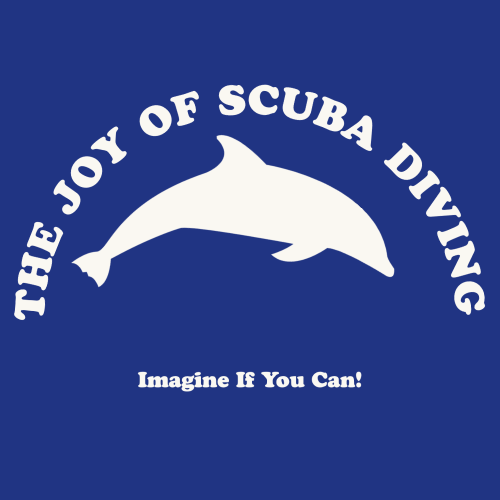
This is the perfect page for a person going a vacation. I scuba dive pretty much on my own and usually find I can meet someone to buddy up with. I did a liveaboard dive out in Belize couple of years ago and it was nice easy diving. I have only done about 35 dives total. I also have a friend that doesn’t dive and thinking Turks and Caicos would be perfect for her to snorkel. I’ll see what she thinks and get back to you. Also, is there a page where I can buy fins for myself? Thanks.
Hi Ryan, thanks for your great comment and question. I used to live in Grand Turk, Turks & Caicos Islands and diving and snorkelling is excellent anywhere you go out on the islands. Great visibility, little to none on currents and lots to see. You will definitely enjoy your liveaboard dives and your friend will enjoy her snorkelling.
Fins, yes… you can check out this article on the Mares Avanti Quattro Plus Adjustable Heel Straps, they’re very good fins and you’ll enjoy wearing them . https://joyofscubadiving.com/m…
Please let me know if you have any other questions.
Regards,
Monica
A very informative article. I recently got my Open Water Dive certification and have been doing researches on liveaboards. I’ve been feeling nervous about booking with them because it seems people that go diving from diveaboards are very experienced divers. It’s wonderful to know there are liveaboards that will actually cater to people like me who have done little amount of dives. I actually did my certification in Cozumel so I think the Caribbean liveaboard destinations will make me feel more comfortable. Your videos are getting me to think I need to start planning a vacation for this year. Thanks and I’ll be getting back to you because I’m sure I’ll have questions…
Hey Mark, thank you for your great comment. That’s wonderful.. I’m glad to hear you’re going to start planning a liveaboard vacation this year. It would be good if you have time before you depart for your vacation to do some dives in between just to keep your training fresh. Even a couple of dives with a local dive shop.
Let me know if you have any questions.
Regards,
Monica